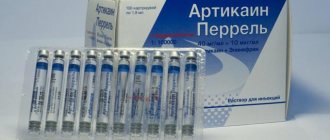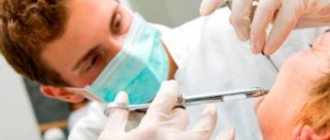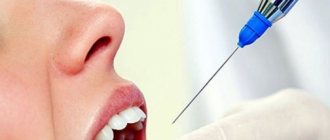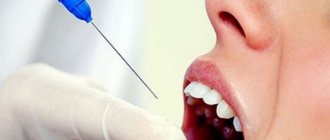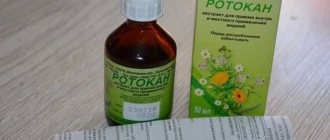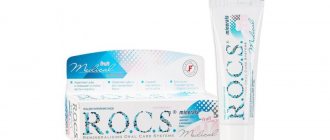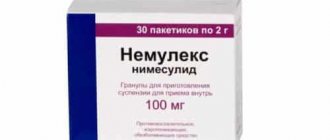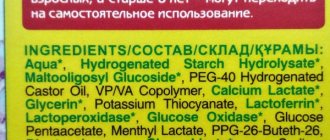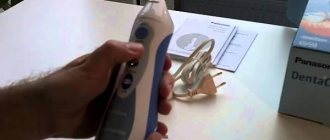From this article you will learn:
- reviews on Ultracain, release forms,
- pros and cons of the drug,
- How much does Ultracaine anesthesia cost?
The article was written by a dental surgeon with more than 19 years of experience.
The anesthetic Ultracaine is a drug in the form of an injection solution that has a very high analgesic effect when administered locally into tissues. The main active component of ultracaine is the substance “articaine hydrochloride” (Articaine), which makes it possible to classify this drug as an anesthetic of the articaine series. Ultracaine is most often used in dentistry, which is explained by its high efficiency.
There are several forms of release of this drug, which differ from each other in the concentration of the vasoconstrictor component (epinephrine) included in ultracaine. It is added to articaine to locally reduce blood supply in the anesthesia zone and reduce the leaching of the anesthetic from the tissues. Those. Epinephrine increases the duration and depth (strength) of anesthesia.
Anesthetic Ultracaine and carpule syringe –
For dentistry, the anesthetic is available both in the form of regular injection ampoules and special cartridges called carpules (these are most often used). The anesthetic carpule is inserted inside a special carpule syringe, which has a piston in the form of a handle, and a special double-edged needle is inserted into it from the side of the syringe nose. When pressing on the syringe piston, the latter presses on the movable rubber liner inside the carpule, which leads to an increase in pressure inside the carpule and the release of the anesthetic solution through the needle.
Ultracaine release forms –
- ultracaine DS-forte (epinephrine concentration 1:100,000),
- ultracaine DS (epinephrine concentration 1:200,000),
- ultracaine D (without epinephrine).
The presence of three forms of drugs is explained by the possible side effects of epinephrine, which can increase the patient's blood pressure. For completely healthy people who do not have cardiovascular or other diseases, Ultracain DS Forte is used. For moderately high blood pressure, Ultracaine DS with a reduced concentration of epinephrine can be used. However, the instructions for use for Ultracain indicate that any of the listed forms can be used from the age of 4 years. We will tell you more about the indications for use of each form below.
How anesthesia is performed in dentistry: video
Ultracaine: price of anesthesia
The cost of 1 carpule of Ultracaine is from 90 rubles (this is the price at which dental clinics purchase it). But in a dental clinic using Ultracain, the price for anesthesia will be approximately 400 to 500 rubles. Unfortunately, you won’t be able to buy a carpule of anesthetic at a pharmacy and bring it with you. This is strictly prohibited by law, because... In this case, the dentist cannot guarantee that the anesthetic is not counterfeit or that it was stored correctly. As a result, the dentist will in any case be to blame for the complications and will be held responsible for it.
Forms of release of the anesthetic Ultracaine -
Ultracaine: the composition, regardless of the release form, 1 carpool of anesthetic contains the anesthetic articaine 40 mg, and the volume of anesthetic solution in the carpul will be 1.7 ml. As for the content of epinephrine, as we said above, each of the three forms will have its own concentration of this vasoconstrictor component (vasoconstrictor). It should also be noted that ultracaine anesthetic contains the preservative sodium disulfite, which is designed to stabilize epinephrine in the drug. Moreover, since Ultracain D is produced without epinephrine, it will not contain preservatives.
Ultracaine DS forte (epinephrine 1:100.000) –
An excellent anesthetic for achieving a pronounced and long-lasting analgesic effect during surgical interventions in the oral cavity, for depulping teeth, etc. However, this form cannot be used for high blood pressure, severe cardiovascular diseases, thyroid disease and bronchial asthma.
For detailed instructions from the manufacturer, read: → Ultracain DS forte – instructions for use (PDF)
Ultracaine DS (epinephrine 1:200.000) –
The best option for use in patients at risk - pregnant and lactating women, patients with compensated cardiovascular diseases. It is undesirable to use for bronchial asthma. Cannot be used for thyroid diseases.
For detailed instructions from the manufacturer, read: → Ultracain DS – instructions for use (PDF)
Ultracaine D (without epinephrine) –
The optimal choice if there is a high risk of allergic reactions, because... This anesthetic is completely free of any preservatives that are necessary to stabilize anesthetics containing adrenaline. In this regard, it is a good choice also for patients with bronchial asthma. Due to the absence of adrenaline, it can be used for diseases of the thyroid gland. The absence of adrenaline allows its use in patients with severe cardiovascular disorders, but it must be taken into account that the duration of action of the anesthetic without epinephrine/adrenaline will be no more than 20 minutes.
For detailed instructions from the manufacturer, read: → Ultracain D – instructions for use (PDF)
Artikain
Articaine is a clear, colorless or yellowish solution for injection.
Indications for use: Infiltration and conduction anesthesia in dentistry. The drug is optimal when working with patients with a history of allergies, in gerontological and pediatric dentistry, and in patients with cardiovascular diseases. The onset of pain relief is from 1 to 3 minutes. Effective anesthesia time is at least 20 minutes. It is possible to prolong anesthesia by injecting the anesthetic.
Analogue of the drug: Ultracain D
Articaine is a local anesthetic (thiophene derivative) for infiltration and conduction anesthesia in dental practice, has a pronounced local anesthetic effect. In tissues (in a slightly alkaline environment) it undergoes hydrolysis and releases a base that has lipophilic properties and easily penetrates the membrane into the nerve fiber.
Articaine interacts with receptors, blocks sodium channels in the nerve fiber membrane, thus providing a local anesthetic effect. The effect of the drug begins quickly (the latent period is 1-3 minutes). Duration of action: 20 minutes. The rapid destruction of articaine to an inactive metabolite - articainic acid - is the reason for its very low toxicity, which allows repeated administration of the drug. In an acidic environment the effect is reduced.
Compound:
1 ml of solution contains: active substance: articaine hydrochloride - 40 mg; excipients: sodium chloride – 2.1 mg water for injection up to 1 ml.
Instructions for use
Before administering the drug, it is always recommended to perform an aspiration test in order to avoid intravascular administration of the drug. The pressure on the piston during drug administration should be adjusted depending on tissue sensitivity. Administration of the drug into inflamed areas of the mucous membrane is not recommended. Eating is allowed only after sensitivity has been restored.
For uncomplicated extraction of maxillary teeth in the non-inflammatory stage - 1.7 ml per tooth into the vestibular depot; if necessary, additionally - 1.0-1.7 ml.
For anesthesia for palatal incisions and suturing to create a palatal depot - 0.1 ml.
When removing premolars of the lower jaw (5-5) in an uncomplicated stage, infiltration anesthesia gives the effect of conduction anesthesia.
When preparing cavities and grinding teeth for crowns , with the exception of molars of the lower jaw, a vestibular injection of 0.5 - 1.7 ml per tooth.
When performing one treatment procedure, the maximum dose for adults is 4 mg/kg body weight.
Use during pregnancy and lactation: The safety of Articaine during pregnancy has not been established due to insufficient clinical data. Articaine penetrates the placental barrier. The question of using the drug by a dentist can only be accepted if the potential benefit from its use justifies the potential risk to the fetus. Has no effect on the fetus (except for possible bradycardia) with any technique of application and dose. During lactation there is no need to interrupt breastfeeding, since clinically significant concentrations of Articaine are not found in breast milk.
Contraindications: Hypersensitivity to articaine or other local anesthetic drugs of the amide group; megaloblastic B12 deficiency anemia; angle-closure glaucoma; diseases of the central nervous system; chronic hypoxia; bronchial asthma. Paroxysmal tachycardia; atrial fibrillation; severe cardiac conduction disturbances (for example, atrioventricular block II-III degree, severe bradycardia), acute heart failure, arterial hypotension. Volumetric maxillofacial operations, as well as with intervention durations exceeding 20 minutes. Children under 4 years of age (efficacy and safety have not been studied). With caution: Women in labor with preeclampsia, bleeding in the last trimester of pregnancy.
Articaine, detailed instructions for use
, Russia
Shelf life: 3 years
Articaine, solution for injection 40 mg/ml, ampoules 2 ml No. 10 price: 870.00 rub. (on order)
Articaine 40 mg/ml, cartridges 1.7 ml No. 50 price: RUB 1,820.00
Ultracain: reviews from dentists
As a practicing physician, I try to use this particular anesthetic primarily, although its cost is 1.5-2 times more expensive than similar anesthetics based on articaine.
Thanks to the optimal composition, a minimum of preservatives in the composition (and the complete absence of preservatives in the form of Ultracaine D), this anesthetic can be used in all patients at risk (for cardiovascular, endocrine disorders, allergies, pregnancy and lactation). Ultracaine reviews from dentists are also as favorable as possible because this anesthetic will be a good choice if you have an allergic reaction to amide group anesthetics, for example Novocaine, Lidocaine and others. But in addition to the high safety profile, this anesthetic is also much stronger than its predecessors (see below). In addition, this anesthetic acts in inflamed tissues, but Novocain practically does not anesthetize in the presence of purulent inflammation.
The duration of action and depth of anesthesia will depend on the concentration of epinephrine in the composition of the product, for example, Ultracaine DS forte 1: 100,000 is the most powerful drug in the line. When conducting conduction anesthesia on the lower jaw, the duration of action averages from 2 to 3 hours. With infiltration anesthesia on the lower and upper jaws - a little more than an hour (24stoma.ru).
Ultracaine or lidocaine: which is better?
- Ultracaine is stronger than Novocaine - 5-6 times,
- more effective than lidocaine - 1.5-2 times.
Articaine with adrenaline (Articaine + epinephrine)
Articaine with adrenaline is a clear, colorless or yellowish solution for injection.
Indications for use: Infiltration and conduction anesthesia during dental operations - uncomplicated removal of one or more teeth, treatment of cavities and grinding of teeth before prosthetics in adults and children over 4 years old. The drug can be used in patients at risk, in childhood (children over 4 years old), and during lactation. Effective anesthesia time is at least 45 minutes.
Analogs: Ultracain DS, Ubistezin, Septanest with adrenaline.
Articaine with adrenaline is a combination drug that contains articaine (an amide-type local anesthetic) and epinephrine (a vasoconstrictor), which is added to the drug to prolong anesthesia.
Articaine is a local anesthetic used for infiltration and conduction anesthesia in dental practice. The amide structure of articaine is similar to that of other local anesthetics, but its molecule contains one additional ester group, which is quickly hydrolyzed by esterases in the human body. The rapid destruction of articaine to its inactive metabolite (articainic acid) is associated with its very low systemic toxicity, allowing repeated injections of the drug. Local anesthetics cause reversible loss of sensation by stopping or reducing the conduction of sensory nerve impulses near the injection site. They have a membrane-stabilizing effect by reducing the permeability of nerve cell membranes to sodium ions.
Articaine with adrenaline has a rapid (latent period from 1 to 3 minutes) and strong anesthetic effect and has good tissue tolerance. The duration of anesthesia is at least 45 minutes. Due to the very low content of epinephrine in the drug, the effect of the latter on the cardiovascular system is insignificant: there is almost no increase in blood pressure and an increase in heart rate.
Articaine with adrenaline composition:
1 ml of solution contains: active ingredients: articaine hydrochloride - 40 mg and epinephrine hydrotartrate - 0.009 mg (in terms of epinephrine - 0.005 mg, which corresponds to the content of epinephrine in the solution 1:200,000);
excipients: sodium disulfite - 0.50 mg, sodium chloride - 1.00 mg, water for injection up to 1 ml.
Articaine with adrenaline: method of administration and dosage
The drug is intended for use in the oral cavity and can only be injected into tissues where there is no inflammation. It is impossible to inject into inflamed tissues. The drug cannot be administered intravenously. For anesthesia for uncomplicated extraction of teeth in the upper jaw in the absence of inflammation, it is usually sufficient to create a depot of Articaine with adrenaline in the area of the transitional fold by introducing it into the submucosa from the vestibular side (1.7 ml of the drug per tooth). In rare cases, an additional injection of 1 ml to 1.7 ml may be required to achieve complete anesthesia. In most cases, this eliminates the need for a painful palatal injection. When removing several adjacent teeth, the number of injections can usually be limited.
For anesthesia for incisions and sutures in the palate to create a palatal depot, about 0.1 ml of the drug is required for each injection.
In the case of removal of mandibular premolars in the absence of inflammation, mandibular anesthesia can be dispensed with, since infiltration anesthesia provided by an injection of 1.7 ml per tooth is usually sufficient. If in this way it was not possible to achieve the desired effect, an additional injection of 1-1.7 ml of anesthetic should be performed into the submucosa in the area of the transitional fold of the mandible on the vestibular side. If in this case it was not possible to achieve complete anesthesia, it is necessary to conduct a conduction block of the mandibular nerve.
When treating cavities and grinding teeth for crowns , with the exception of the lower molars, depending on the volume and duration of treatment, the introduction of Articaine with adrenaline into the area of the transitional fold on the vestibular side in a dose of 0.5-1.7 ml per tooth is indicated.
When performing one treatment procedure, adults can be administered articaine in a dose of up to 7 mg per 1 kg of body weight. It was noted that patients tolerated doses up to 500 mg (corresponding to 12.5 ml of solution for injection) well.
For pediatric patients (over 4 years old), the dose of Articaine with adrenaline is selected depending on the age and body weight of the child, but it should not exceed 5 mg of articaine per 1 kg of body weight.
In elderly patients and all patients with severe renal and hepatic insufficiency, increased plasma concentrations of articaine may occur. For these patients, the minimum doses necessary to achieve a sufficient depth of anesthesia should be used.
To avoid accidental entry of the drug into the blood vessels, before its administration, a two-stage aspiration test should always be performed with the needle rotated 90 and 180 (see detailed instructions).
Severe systemic reactions due to unintentional intravascular administration of the drug can be prevented by slow administration: first inject 0.1-0.2 ml of the drug, then, after 20-30 s, slowly inject the rest of the drug. The injection pressure should correspond to the sensitivity of the tissue.
Contraindications: Hypersensitivity to articaine or to other amide-type local anesthetics, unless in case of hypersensitivity to amide-type local anesthetics, an allergy to articaine has been excluded by appropriate studies conducted in compliance with all necessary rules and requirements. Hypersensitivity to epinephrine; hypersensitivity to any of the auxiliary components of the drug. (see detailed instructions).
Articaine with adrenaline (Articaine + epinephrine), detailed instructions for use
Articaine with adrenaline (Articaine + epinephrine)
, Russia
Shelf life: 2.5 years for cartridges, 3 years for ampoules
Articaine with adrenaline, solution for injection (40 mg+0.005 mg)/ml, ampoules 2 ml No. 10 price: 870.00 rub. (on order)
Articaine with adrenaline 40+0.005 mg/ml cartridges (1:200,000) 1.7 ml No. 50 price: RUB 1,705.00
Ultracaine during pregnancy and breastfeeding
The optimal form of this anesthetic during pregnancy is Ultracaine DS with an epinephrine concentration of 1:200,000. The use of anesthetics without epinephrine (or adrenaline) in pregnant and lactating women is generally not recommended. This is due to the fact that adrenaline, by constricting blood vessels at the injection site, slows down the absorption of the main component (articaine) into the blood, and accordingly this will reduce the peak concentrations of articaine in the blood, and therefore its possible side effects on the fetus.
Ultracaine during breastfeeding - after anesthesia with Ultracaine, the content of articaine in breast milk is possible, but the concentration is so low that it cannot cause any harm. Therefore, there is no need to give up breastfeeding. The epinephrine content in Ultracaine DS is also very small and cannot adversely affect either the mother or the child.
Sources:
1. Dental education of the author of the article, 2. Based on personal experience as a dentist, 3. National Library of Medicine (USA), 4. “Local anesthesia in dentistry” (Baart J.), 5. https://dental.sanofi. de/.
